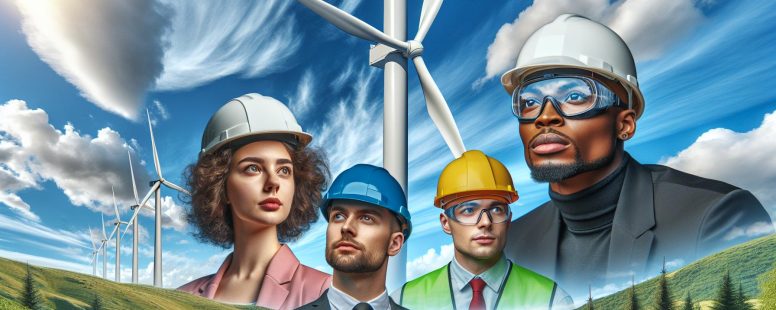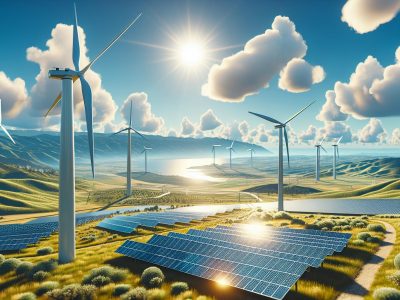Pros and Cons of Wind Turbines: Benefits, Challenges, and Future Potential Explained
Imagine standing in an open field, the rhythmic whoosh of massive blades slicing through the air as they harness the invisible power of the wind. Wind turbines have become symbols of clean energy and innovation, promising a future less reliant on fossil fuels. But beneath their sleek, towering design lies a mix of benefits and challenges that spark debate.
You’ve likely heard about their role in reducing carbon emissions, but have you considered their impact on local ecosystems or the communities they’re built near? Wind turbines offer a fascinating blend of progress and complexity, making them both a solution and a subject of scrutiny. Understanding the pros and cons can help you see the bigger picture of how they shape our environment and energy future.
Overview Of Wind Turbines
Wind turbines transform kinetic energy from wind into mechanical energy, which is then converted into electricity. These structures, typically comprising a tower, blades, and a nacelle, aid in generating renewable energy with minimal greenhouse gas emissions. Modern designs include horizontal-axis turbines (commonly used for large-scale energy production) and vertical-axis turbines (suitable for cities or smaller setups).
The output of wind turbines depends on location and wind speed. Areas with consistent wind patterns, such as plains, coastlines, or offshore locations, see high performance. For example, the United States’ Great Plains region, known as the “wind corridor,” produces substantial energy annually. Even though this, not all areas have sufficient wind resources to justify turbine installation.
Wind turbines’ sizes vary significantly. Large utility-scale turbines can reach over 600 feet in height, generating up to 4.8 MW per unit. By contrast, small-scale turbines designed for residential or farm use are often under 100 feet tall with outputs below 100 kW.
Environmental benefits are considerable since these turbines don’t emit pollutants during operation. Yet, challenges arise, such as noise generation and bird or bat fatalities caused by blade strikes. Local concerns often center on visual impact and potential property devaluation near wind farms.
Advancements in wind turbine technologies aim to address existing challenges. For instance, blade designs that minimize wildlife impact and noise are in evaluation stages. Also, floating offshore turbines are expanding energy access to deeper ocean regions, significantly increasing global generation potential.
Benefits Of Wind Turbines
Wind turbines offer multiple advantages, contributing to a sustainable and greener energy system.
Renewable Energy Source
Wind is an inexhaustible and widely available energy source. Unlike fossil fuels, which take millions of years to form, wind energy replenishes naturally and doesn’t deplete. Geographic regions like the Great Plains in the US and offshore locations experience consistent winds, providing ideal conditions for large-scale turbine installations. By utilizing wind resources, you reduce reliance on limited, non-renewable energy reserves.
Reduction In Carbon Emissions
Wind turbines generate electricity without burning fossil fuels. This eliminates greenhouse gas emissions during operation, unlike coal or natural gas plants. According to the U.S. Energy Information Administration, a single utility-scale turbine can offset 1,500 tons of CO2 annually, equating to the emissions of approximately 300 passenger vehicles. Large-scale wind farms play a pivotal role in combating the effects of climate change and promoting cleaner air.
Cost-Effective In The Long Run
Although initial installation costs can be high, wind turbines have low operational expenses. Wind is free, unlike fluctuating fossil fuel prices, allowing for more stable long-term energy costs. After an average payback period of 15 to 20 years, turbines often provide decades of virtually free electricity. For example, Denmark and Germany have seen significant reductions in electricity costs due to established wind energy infrastructures.
Job Creation In Renewable Energy Sector
The wind energy sector has created thousands of jobs in engineering, manufacturing, construction, and maintenance. The Global Wind Energy Council estimates over 1.2 million people work in the wind industry worldwide. Local economies benefit from new manufacturing plants, service centers, and skilled labor opportunities. For instance, Texas, leading in wind capacity, has generated about 25,000 related jobs, boosting its renewable economy.
Challenges Of Wind Turbines
Wind turbines contribute significantly to renewable energy but face several challenges that impact their adoption and efficiency. Addressing these issues is crucial for maximizing their benefits.
Environmental Impact On Wildlife
Wind turbines can disrupt local ecosystems, particularly affecting birds and bats. Studies by the U.S. Fish and Wildlife Service estimate wind turbines cause hundreds of thousands of bird fatalities annually. Species like golden eagles and migratory birds are at higher risk near wind farms located in their habitats. Similarly, bats, critical for controlling insect populations, are affected due to barotrauma—a condition caused by sudden pressure changes near turbine blades. While mitigation strategies like turbine curtailment during peak migration and improved blade designs show promise, concerns persist among conservationists.
Dependence On Weather Conditions
Wind turbines rely heavily on consistent wind speeds to generate electricity efficiently. Inconsistent or low wind conditions reduce energy output, making locations with unpredictable weather less suitable. For example, turbines in regions with average wind speeds below 6.5 meters per second experience lower efficiency. Modern storage solutions like battery systems can offset this limitation but often increase overall costs and resource use. Seasonal variations further challenge grid reliability in areas dependent on wind energy, particularly during prolonged calm periods.
High Initial Installation Costs
Installing wind turbines involves substantial upfront investment, particularly for utility-scale projects. Costs include land acquisition, transportation, foundations, and specialized equipment like blades and towers. For instance, a single large turbine can cost millions of dollars, with additional expenses for grid connections. Though operational maintenance costs are relatively low, the initial outlay can deter investments, especially in developing regions. Governments often provide subsidies or tax credits to offset costs, but these financial structures vary by location and availability.
Noise And Aesthetic Concerns
Wind turbines can produce noise levels between 35 to 50 decibels, comparable to a household refrigerator, but noticeable for residents living nearby. Low-frequency sounds may lead to discomfort for sensitive individuals. Also, turbines alter landscapes visually, creating opposition in areas with significant natural or cultural importance. In some communities, concerns over aesthetic disruption have led to delays in project approval or even cancellations. Balancing energy demands with community preferences remains a contentious issue globally.
Comparing Benefits And Challenges
Understanding the balance between the advantages and disadvantages of wind turbines helps you evaluate their role in sustainable energy production. This section examines the economic, environmental, and technological dimensions of wind energy.
Balancing Economic And Environmental Factors
Economic benefits, such as job creation and energy cost stability, contrast with environmental impacts. Wind energy creates jobs in construction, maintenance, and manufacturing; in the U.S., the industry employed over 116,000 workers by 2022, according to the U.S. Bureau of Labor Statistics. Also, lower operational costs after installation contribute to long-term cost savings.
Environmental factors raise concerns about habitat disruption. For instance, wind turbines can harm bird populations; the American Bird Conservancy estimates up to 679,000 bird fatalities annually in the U.S. alone. To address this, technologies like ultrasonic deterrents have been implemented to reduce wildlife injuries.
Regions dependent on fossil fuels may see lower emissions yet face economic shifts. Transitioning may require retraining workforces, which could delay adoption in areas with coal- or oil-dominated industries. Balancing economic progress with ecological preservation remains a crucial challenge for stakeholders.
Addressing Technological Limitations
Technological limitations directly impact efficiency and scalability. Wind turbines operate optimally with wind speeds of 6.7–33.5 mph; regions outside this range may experience inconsistent output. Innovations like floating offshore turbines aim to harness winds over deeper waters, yet their costs limit widespread use.
Grid integration presents another challenge. Intermittent energy supply from wind requires storage solutions or hybrid energy systems to ensure reliability. Battery storage systems, like Tesla’s Powerwall, provide options but remain costly for large-scale implementation.
The materials used in turbine construction also pose constraints. Large turbine blades, often made of composite materials, are difficult to recycle. In 2019, over 8,000 blades reached end-of-life status in the U.S. and were discarded in landfills instead of being repurposed. Advanced materials research focuses on creating degradable or recyclable components to address this issue.
There’s no perfect solution for replacing conventional energy sources, but technological progress continues to address existing inefficiencies. Encouraging global collaboration and innovation accelerates the transition to more sustainable frameworks.
Future Potential Of Wind Turbines
Rapid advancements and increasing adoption are fueling the future potential of wind turbines. These trends could reshape energy landscapes worldwide by integrating more sustainable energy solutions.
Advances In Turbine Technology
Technological innovations are expanding the efficiency and capabilities of wind turbines. Larger rotor blades and taller towers are allowing turbines to capture energy at greater altitudes, where wind speeds are often higher. For example, General Electric’s Haliade-X turbine reaches a height of 260 meters and generates up to 14 MW, powering around 12,000 homes annually.
Offshore wind farms are also transforming energy production. Floating turbines, like those in Norway’s Hywind project, harness winds in deep waters, which account for 80% of global offshore wind resources. These designs reduce land-use conflicts and unlock untapped energy potential but require advanced materials to withstand harsh marine environments.
Energy storage systems are critical for balancing intermittency. Improved battery technology and grid integration tools, such as virtual power plants (VPPs), address the challenge of fluctuating energy outputs. Alongside these technological strides, 3D printing and lightweight composite materials enable cost-effective manufacturing.
Increasing Adoption Globally
Worldwide adoption rates illustrate growing dependence on wind energy. According to the Global Wind Energy Council, installed wind capacity reached 837 GW in 2022, representing a 15% increase over the previous year. China leads with 388 GW, while the U.S. follows with over 140 GW, highlighting diverse energy policy implementations.
Emerging economies are embracing wind power to meet energy demands sustainably. In India, wind farms in Tamil Nadu contribute to over 25% of the state’s electricity, reducing reliance on coal. Policies like feed-in tariffs and subsidies drive this growth, but infrastructure gaps present barriers.
Community-led projects are fostering local participation. One example includes the Middelgrunden offshore wind farm in Denmark, 50% owned by cooperative members. These initiatives encourage public acceptance, yet concerns like world changes and costs must be addressed.
Conclusion
Understanding the pros and cons of wind turbines is essential for making informed decisions about their role in our energy future. While they offer significant environmental and economic benefits, challenges like wildlife impact, noise, and high initial costs cannot be ignored.
As technology evolves and global collaboration increases, the potential of wind energy continues to grow. By addressing existing limitations and fostering innovation, you can help ensure wind turbines remain a key player in the transition to a more sustainable energy world.
- King vs Queen Size Bed: An In-Depth Comparison for Your Perfect Mattress Choice - October 29, 2025
- Krill Oil vs Fish Oil: Key Differences, Benefits, and Choosing the Right Omega-3 Source - October 29, 2025
- Understanding the Difference Between OT and PT: A Comprehensive Guide - October 29, 2025







